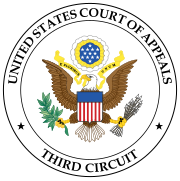Apple v. Franklin
| Apple Computer, Inc. v. Franklin Computer Corp. | |
|---|---|
 |
|
| Court | United States Court of Appeals for the Third Circuit |
| Full case name | Apple Computer, Inc. v. Franklin Computer Corp. |
| Argued | March 17 1983 |
| Decided | August 30 1983 |
| Citation(s) | 714 F.2d 1240 (3d Cir. 1983); 70 A.L.R.Fed. 153, 219 U.S.P.Q. 113, 1983 Copr.L.Dec. P 25,565 |
| Case history | |
| Prior action(s) | Injunction denied, E.D. Pa. July 30, 1982; motion for reconsideration denied |
| Subsequent action(s) | Rehearing and rehearing en banc denied, 3d Cir. Sept. 23, 1983 |
| Holding | |
| Computer software could be protected by copyright. District Court reversed and remanded. | |
| Court membership | |
| Judge(s) sitting | Circuit Judges James Hunter III, A. Leon Higginbotham, Jr., Dolores Sloviter |
| Case opinions | |
| Majority | Sloviter, joined by Hunter, Higginbotham |
| Laws applied | |
| Copyright Act of 1976 | |
Apple Computer, Inc. v. Franklin Computer Corp., 714 F.2d 1240 (3d Cir. 1983), was the first time an appellate level court in the United States held that a computer's operating system could be protected by copyright. As second impact, this ruling clarified that binary code, the machine readable form of software, was copyrightable too and not only the human-readable source code form of software.
Franklin Computer Corporation introduced the Franklin Ace 1000, a clone of Apple Computer's Apple II, in 1982. Apple quickly determined that substantial portions of the Franklin ROM and operating system had been copied directly from Apple's versions, and on May 12, 1982, filed suit in the United States District Court for the Eastern District of Pennsylvania. It cited the presence of some of the same embedded strings, such as the name "James Huston" (an Apple programmer), and "Applesoft," on both the Apple and Franklin system disks.
Franklin admitted that it had copied Apple's software but argued that it would have been impractical to independently write its own versions of the software and maintain compatibility, although it said it had written its own version of Apple's copy utility and was working on its own versions of other software. Franklin argued that because Apple's software existed only in machine-readable form, and not in printed form, and because some of the software did not contain copyright notices, it could be freely copied. The Apple II firmware was likened to a machine part whose form was dictated entirely by the requirements of compatibility (that is, an exact copy of Apple's ROM was the only part that would "fit" in an Apple-compatible computer and enable its intended function), and was therefore not copyrightable.
...
Wikipedia
